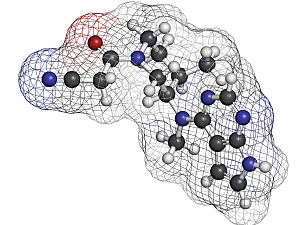In 2019, the FDA recommended a black box label for tofacitinib to warn prescribers of a risk of venous thromboembolism (VTE). The concern arose when a greater risk of thrombotic events was noted with a 10 mg twice-daily dose of tofacitinib, compared with 5 mg or a tumor necrosis factor-α inhibitor (TNFi), in an ongoing post-marketing safety trial in rheumatoid arthritis (RA).
While rheumatologists were waiting for full results of the postmarketing safety trial of tofacitinib, studies of “real-world” health care data could be informative. Researchers at Brigham and Women’s Hospital previously compared tofacitinib with TNFis using 2012–2016 data from two large U.S. insurance datasets. Their report in Arthritis & Rheumatology noted a numerical increase in the risk of VTE with tofacitinib among patients with RA, but the difference from TNFis was not statistically significant.
Recently, the team added data from more recent years and included a third database, presenting their results in Rheumatology (Oxford). Brigham and Women’s Seoyoung C. Kim, MD, ScD, director of the Program in Rheumatologic, Immunologic, and Musculoskeletal PharmacoEpidemiology (PRIME) and physician in the Division of Rheumatology, Inflammation, and Immunity, Michael E. Weinblatt, MD, co-director of Clinical Rheumatology in that division, Rishi J. Desai, PhD, associate epidemiologist in the Division of Pharmacoepidemiology and Pharmacoeconomics, and colleagues say the updated analysis still shows no increased risk of VTE in patients with RA who use tofacitinib compared with TNFis in routine care settings.
Methods
The researchers analyzed data on two mutually exclusive groups of adults with RA: those who filled a prescription for a TNFi (adalimumab, certolizumab, etanercept, golimumab or infliximab) or tofacitinib. Other eligibility criteria were no cancer, no history of VTE, and no prior use of tofacitinib, any TNFi, any other biologic, or a targeted synthetic disease-modifying antirheumatic drug.
The datasets examined were:
- IBM’s MarketScan, 2012–2018 (n=42,201; mean age 50; 7% tofacitinib users)
- Optum’s Clinformatics, 2012–2019 (n=20,374; mean age 52; 10% users)
- Medicare parts A, B and D, 2012–2017 (n=25,078; mean age 71; 7% tofacitinib users)
Incidence of VTE
VTE was infrequent in these 87,653 RA patients: 29 inpatient diagnoses were recorded for tofacitinib users and 365 for TNFi users. There were minimal differences between groups in incidence rates per 100 person-years:
- MarketScan—0.42 for tofacitinib vs. 0.35 for TNFis
- Optum—0.19 vs. 0.34
- Medicare—1.18 vs. 0.83
- Pooled—0.55 vs. 0.48
The higher rates in the Medicare group are probably attributable to the higher average age and accompanying higher comorbidity burden.
Incidence of VTE After Propensity Matching
To reduce confounding inherent in a nonrandomized study, the researchers conducted the new user, active comparator cohort study and used propensity score weighting methods to account for 60 baseline covariates related to RA treatment history and risk of VTE.
The propensity score weighted analysis confirmed no appreciable difference between the two groups in the risk of VTE, with widely overlapping confidence intervals:
- MarketScan—HR, 1.05 (95% CI, 0.55–2.00)
- Optum—0.47 (0.15–1.50)
- Medicare—1.41 (0.84–2.36)
- Pooled—1.13 (0.77–1.65)
The pooled propensity score–weighted risk was also nonsignificant for:
- Deep vein thrombosis alone—HR, 1.00 (95% CI, 0.79–1.26)
- Pulmonary embolism alone—1.02 (0.60–1.73)
Guidance for the Clinic
Although VTE is relatively infrequent, it’s been reported in Arthritis Care & Research (Hoboken) that RA patients are at more than two-fold increased risk compared with age- and sex-matched patients without RA. Chronic inflammation may explain this difference.
Therefore, rheumatologists should bear in mind the possibility of VTE in RA patients regardless of the drugs prescribed. Along these lines, it’s important to note that VTE has occurred during trials of the newer JAK inhibitors baricitinib and upadacitinib, and like tofacitinib, these agents carry a black box warning about thrombotic events.
A recent study published in The New England Journal of Medicine reported that, in a cardiovascular risk-enriched cohort of patients with active rheumatoid arthritis, several adverse events were more common with tofacitinib than with a TNFi.
